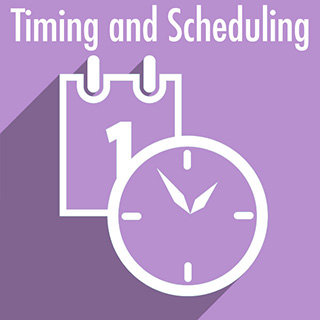What types of accommodations are commonly used for students with disabilities?
Page 8: Timing and Scheduling Accommodations
 Timing and scheduling accommodations allow for changes to how time is organized. These changes can include giving a student more time to complete a test or assignment, breaking a long assignment into smaller pieces or chunks, and allowing the student to receive instruction or take a test during a particular time of day. These adjustments often reduce students’ frustration and fatigue, thereby allowing them the opportunity to access and demonstrate their learning. Timing and scheduling accommodations provide support that allows students with disabilities to access the same instructional opportunities as students without disabilities. As with the other categories, keep in mind that timing and scheduling accommodations:
Timing and scheduling accommodations allow for changes to how time is organized. These changes can include giving a student more time to complete a test or assignment, breaking a long assignment into smaller pieces or chunks, and allowing the student to receive instruction or take a test during a particular time of day. These adjustments often reduce students’ frustration and fatigue, thereby allowing them the opportunity to access and demonstrate their learning. Timing and scheduling accommodations provide support that allows students with disabilities to access the same instructional opportunities as students without disabilities. As with the other categories, keep in mind that timing and scheduling accommodations:
- Do not change the expectations for learning
- Do not reduce the requirements of the task
- Do not change what the student is required to learn
The table below provides examples, though not an exhaustive list, of timing and scheduling accommodations that address common barriers or challenges students experience when they access or demonstrate learning.
| Timing and Scheduling Accommodations | |
| Common Barrier | Example Accommodations |
| Processing information |
|
| Staying focused or maintaining attention |
|
| Stamina (i.e., fatigues easily, reduced energy due to medication or medical condition) |
|
| Frustration and anxiety |
|
| Dexterity |
|
| Completing work on time because assistive technology or other equipment requires more time |
|
| Managing time |
|
As was the case for other categories of accommodations, some of the accommodations in the table above—for example, timelines—are also instructional strategies or interventions. How can teachers tell the difference between the two when they plan instruction for an individual student? As outlined in the table below, one key difference is the purpose for which each is used.
| Accommodation | Instructional Strategy or Intervention | |
| Definition | Adaptation or change in practices or educational environments (e.g., changes to how time is organized) | Instructional strategy or intervention (e.g., a time-management strategy) |
| Purpose |
Addresses a barrier related to the disability
Allows students with disabilities to access learning opportunities equivalent to those of students without disabilities (i.e., levels the playing field) |
Addresses a skill or knowledge deficit but does not specifically address a barrier or increase access
Improves the performance of most students with or without disabilities |
| Example: Timeline | Omar has an emotional/behavioral disorder and experiences anxiety when assigned long-term assignments. In addition to the timeline the class receives for completing each portion of the assignment, the teacher further breaks down each portion into a daily list of items Omar needs to complete to stay on track. This eases his anxiety, allowing him to focus on the task at hand. | Many students in Mrs. Templeton’s class fail to turn in long-term assignments on time. For this reason, she decides to implement a timeline for completing each portion of the assignment to help her students manage their time better and turn in assignments by the due date. |
Following are examples of timing and scheduling accommodations teachers can use to help students access or demonstrate learning.

Kaden
Age: 10
Disability: attention deficit hyperactivity disorder (ADHD)
During instruction, Kaden often becomes fidgety and has difficulty remaining in his seat. To address Kaden’s challenges, his teacher decides to allow him to take two or three one-minute breaks (e.g., stand behind his desk) during a 30–45-minute period of instruction.

Rae
Age: 15
Disability: learning disability (LD)
In addition to having difficulty identifying and remembering important information, Rae processes information more slowly than her peers. For this reason, her teacher gives her extended time to take tests. This allows Rae to process what the questions are asking and formulate responses.

Cierra
Age: 6
Disability: autism spectrum disorder (ASD)
During center time, Cierra experiences sensory overload when working with her peers. In response, her teacher allows her to move to an independent activity after working for five minutes. She plans to gradually increase this time as the school year progresses.
Activity
Each of the following scenarios introduces a student with a disability and identifies his or her related challenge.
-
- Choose one accommodation category (presentation, response, setting, and timing and scheduling) that would best address each student’s barrier and learning goal.
- Type in an accommodation from the selected category that would likely support the student in meeting his or her learning goal.
| Scenario | Accommodation Category | Possible Accommodation |
| David, a middle school student with a health impairment, is highly motivated and excels academically. He takes medication that causes drowsiness. Because he takes this medication right before his advanced algebra class, he experiences low energy and often struggles to complete in-class projects. | ||
| Chantal, an eight-year-old with autism spectrum disorder, is highly sensitive to noise and is frequently agitated by hallway and playground activity (which can be heard through the windows). Her teacher would like to address this barrier so that Chantal can complete her work. | ||
| Sixteen-year-old Kari has a speech impairment. During her English II class, students are given 20 minutes to orally present a persuasive argument, a difficult task for Kari who stutters and stammers when orally presenting material. | ||
| Darrin, a 10-year-old who loves to read and excels in vocabulary, has an auditory processing disorder. During class lectures, Darrin has difficulty following and understanding the information covered. |
There are multiple responses for this activity. Below are some examples of appropriate responses.
| Scenario | Accommodation Category | Possible Accommodation |
| David, a middle school student with a health impairment, is highly motivated and excels academically. Because he takes medication that causes drowsiness right before his advanced algebra class, he often experiences low energy and struggles to complete in-class projects. |
Correct answer: Timing and scheduling accommodations Timing and scheduling accommodations allow for changes to how time is organized. These adjustments often reduce students’ frustration and fatigue, thereby allowing them the opportunity to access and demonstrate their learning. |
By allowing David more frequent breaks and multiple sessions to complete the activities, you have provided him time to refresh and do his best work. |
| Chantal, an eight-year-old with autism spectrum disorder, is highly sensitive to noise and is frequently agitated by hallway and playground activity (which can be heard through the windows). Her teacher would like to address this barrier so that Chantal can complete her work. |
Correct answer: Setting accommodations Setting accommodations allow for a change in the environment (e.g., reduced noise) or in how the environment is structured, which allows students to better access and demonstrate their learning. |
Preferential seating away from windows and doors and noise-reducing headphones are good options for reducing noise distractions. |
| Sixteen-year-old Kari has a speech impairment. During her English II class, students are given 20 minutes to orally present a persuasive argument, a difficult task for Kari who stutters and stammers when orally presenting material. |
Correct answer: Response accommodations Response accommodations allow students with disabilities to complete instructional assignments or assessments through ways other than typical verbal or written responses. |
Allowing an alternate response, such as a written report, helps Kari to showcase her ideas without changing the learning expectation. Increased wait time could also allow her to present the persuasive argument orally without the standard time constraints, if Kari is comfortable with this support. |
| Darrin, a 10-year-old who loves to read and excels in vocabulary, has an auditory processing disorder. During class lectures, Darrin has difficulty following and understanding the information covered. |
Correct answer: Presentation accommodations Presentation accommodations allow a student with a disability to access information in ways other than standard visual or auditory means (e.g., by reading or listening). |
An advance organizer gives Darrin the opportunity to review a lecture’s content before hearing it orally presented in class. The teacher could also provide the lecture in an alternate format (e.g., a printed copy of the lecture notes). |